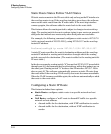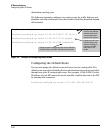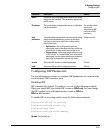
IP Routing Features
Configuring Static IP Routes
destination next-hop pair.
The following example configures two static routes for traffic delivery and
identifies two other null routes for which traffic should be discarded instead
of forwarded.
ProCurve(config)# ip route 10.10.40.0/24 10.10.10.1
ProCurve(config)# ip route 10.10.50.128/27 10.10.10.1
ProCurve(config)# ip route 10.10.20.177/32 reject
ProCurve(config)# ip route 10.10.30.0/24 blackhole
Configures static
routes to two different
network destinations
using the same next-
hop router IP address.
Configures a null route
to drop traffic for the
device at 10.50.10.177
and return an ICMP
notification to the
sender.
Configures a null route to drop traffic for the 10.50.10.0
network without any ICMP notification to the sender.
Figure 3-6. Example of Configuring Static Routes
Configuring the Default Route
You can also assign the default route and enter it in the routing table. The
default route is used for all traffic that has a destination network not reachable
through any other IP routing table entry. For example, if 208.45.228.35 is the
IP address of your ISP router, all non-local traffic could be directed to the ISP
by entering this command:
ProCurve(config)# ip route 0.0.0.0/0 208.45.228.35
3-26


















